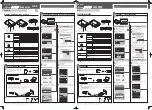
LISA-U1 series - System Integration Manual
3G.G2-HW-10002-3
Preliminary
System description
Page 39 of 125
The recommendations of the antenna producer for correct installation and deployment (PCB
layout and matching circuitry) must be followed.
If an external antenna is used, the PCB-to-RF-cable transition must be implemented using either a suitable 50
connector, or an RF-signal solder pad (including GND) that is optimized for 50 characteristic impedance.
If antenna supervisor functionality is required, the antenna should have a built in DC diagnostic resistor to
ground to get proper antenna detection functionality (See section 2.4.3).
1.8
(U)SIM interface
High-speed SIM/ME interface is implemented as well as automatic detection of the required SIM supporting
voltage.
Both 1.8 V and 3 V SIM types are supported: activation and deactivation with automatic voltage switch from
1.8 V to 3 V is implemented, according to ISO-IEC 7816-3 specifications. The SIM driver supports the PPS
(Protocol and Parameter Selection) procedure for baud-rate selection, according to the values determined by the
SIM Card.
Name
Description
Remarks
VSIM
SIM supply
1.80 V typical or 2.90 V typical
Automatically generated by the module
SIM_CLK
SIM clock
3.25 MHz clock frequency
SIM_IO
SIM data
Open drain, internal 4.7 k pull-up resistor to VSIM
SIM_RST
SIM reset
Table 16: SIM Interface pins
A low capacitance (i.e. less than 10 pF) ESD protection (e.g. Infineon ESD8V0L2B-03L or AVX
USB0002RP) must be placed near the SIM card holder on each line (
VSIM
,
SIM_IO
,
SIM_CLK
,
SIM_RST
). The SIM interface pins ESD sensitivity rating is 1 kV (Human Body Model according to
JESD22-A114F): higher protection level is required if the lines are connected to an SIM card
holder/connector, since they are externally accessible on the application board.
For more details about the general precautions for ESD immunity about SIM interface pins please refer
to chapter 2.5.1.
Figure 20 shows an application circuit connecting the LISA module and the SIM card placed in a SIM card holder,
using the SIM detection function provided by
GPIO5
pin.
Note that, as defined by ETSI TS 102 221 or ISO/IEC 7816, SIM card contacts assignment is as follows:
Contact C1 = VCC (Supply)
It must be connected to
VSIM
Contact C2 = RST (Reset)
It must be connected to
SIM_RST
Contact C3 = CLK (Clock)
It must be connected to
SIM_CLK
Contact C4 = AUX1 (Auxiliary contact for USB interface and other uses)
It must be left not connected
Contact C5 = GND (Ground)
It must be connected to
GND
Contact C6 = VPP (Programming supply)
It must be connected to
VSIM
Contact C7 = I/O (Data input/output)
It must be connected to
SIM_IO
Contact C8 = AUX2 (Auxiliary contact for USB interface and other uses)
It must be left not connected
A SIM card can have 6 contacts (C1 = VCC, C2 = RST, C3 = CLK, C5 = GND, C6 = VPP, C7 = I/O) or 8 contacts
(providing also the auxiliary contacts C4 = AUX1 and C8 = AUX2). The contacts number depends if additional
















































